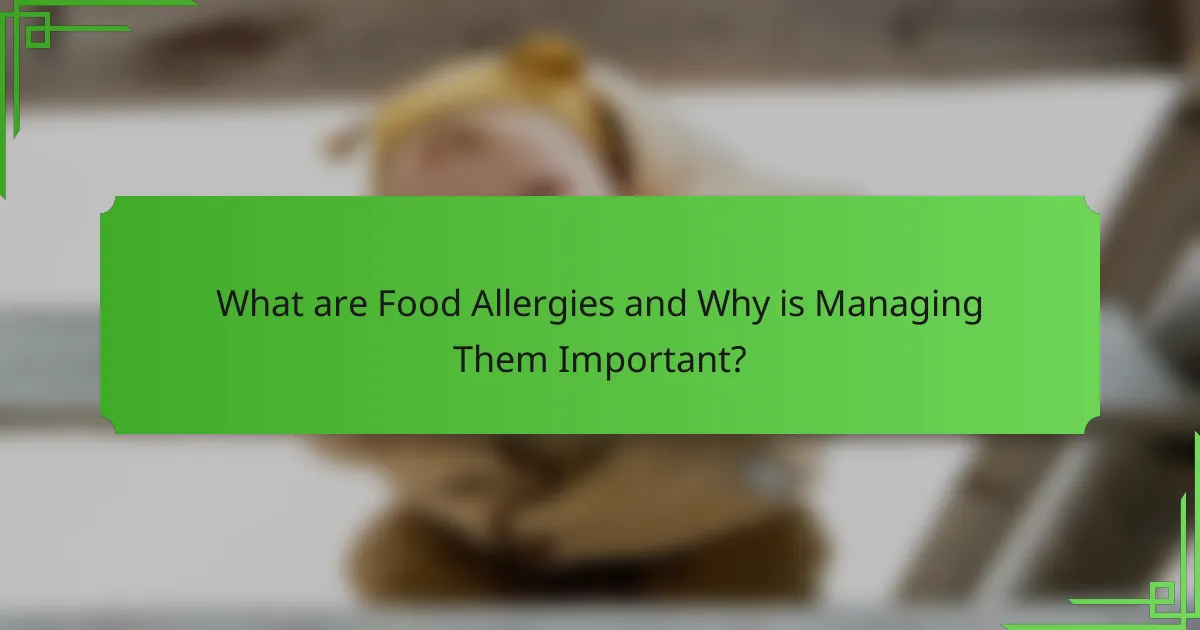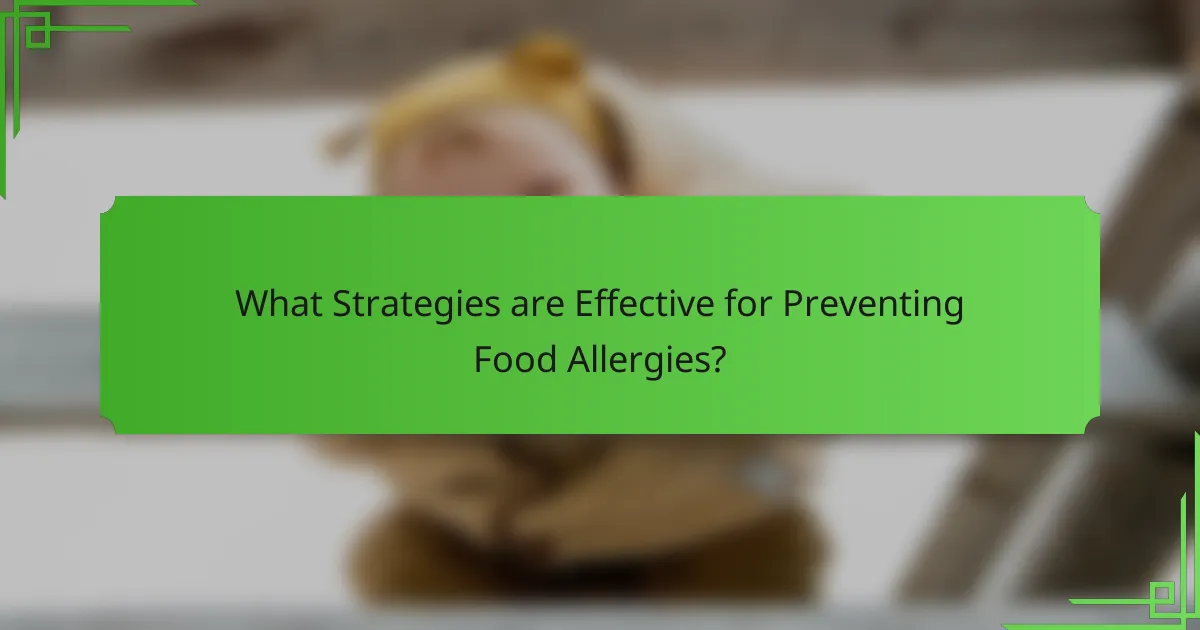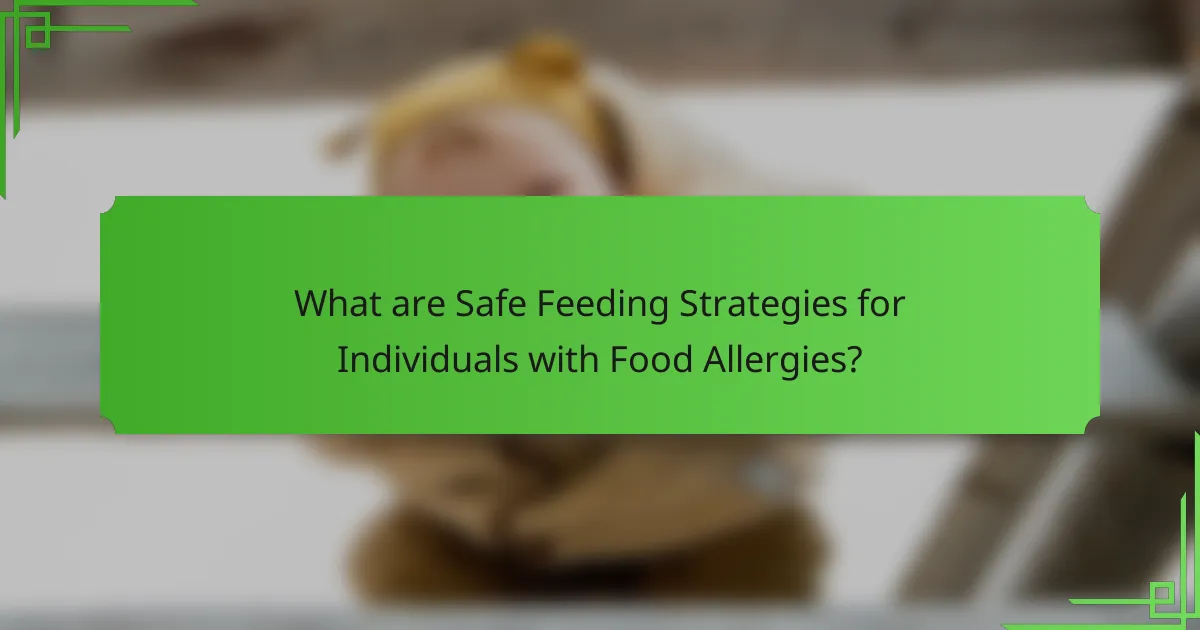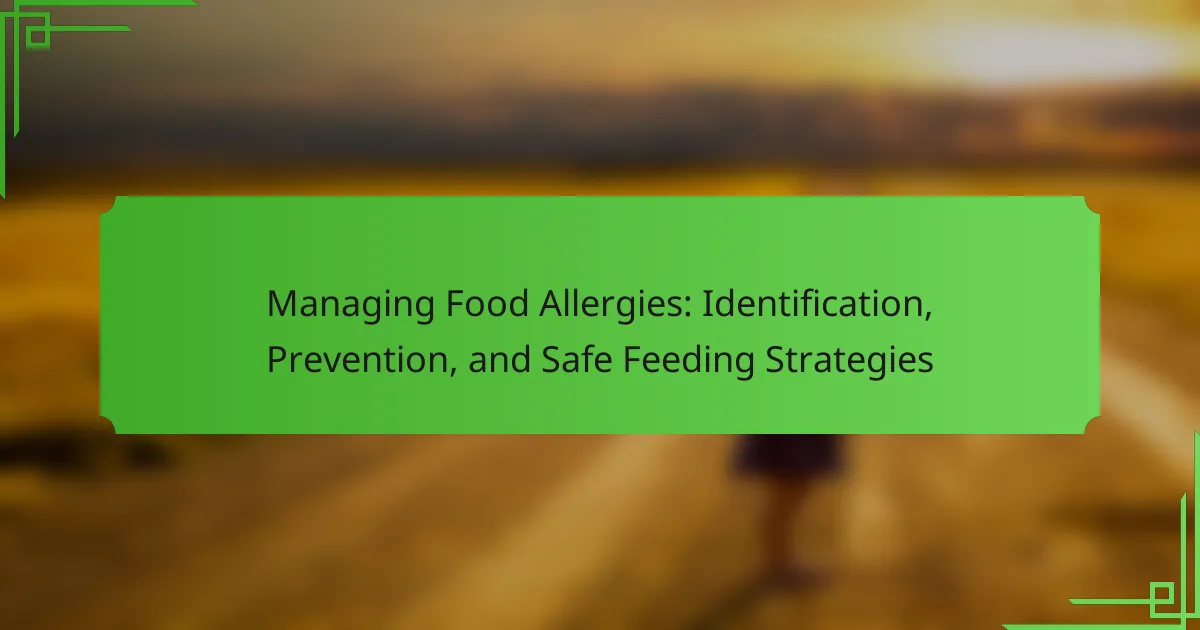Food allergies are immune system reactions that occur when the body mistakenly identifies certain foods, such as peanuts, tree nuts, milk, eggs, wheat, soy, fish, and shellfish, as harmful. Symptoms can range from mild hives to severe anaphylaxis, making effective management essential to prevent dangerous reactions. Identification methods include medical history review, skin tests, blood tests, and elimination diets. Preventive strategies emphasize early introduction of allergenic foods and breastfeeding, while safe feeding practices require strict avoidance of allergens, careful label reading, and clear communication of allergies in dining situations. Understanding these elements is critical for individuals affected by food allergies and their caregivers.

What are Food Allergies and Why is Managing Them Important?
Food allergies are immune system reactions that occur when the body mistakenly identifies certain foods as harmful. Common food allergens include peanuts, tree nuts, milk, eggs, wheat, soy, fish, and shellfish. These allergies can cause symptoms ranging from mild hives to severe anaphylaxis, which can be life-threatening. Managing food allergies is crucial to prevent these potentially dangerous reactions. Proper management includes avoiding trigger foods and carrying emergency medication, such as epinephrine. Statistics show that food allergies affect approximately 8% of children and 4% of adults in the United States. Effective management can significantly reduce the risk of accidental exposure and severe reactions.
How do food allergies develop?
Food allergies develop when the immune system mistakenly identifies certain food proteins as harmful. This triggers an immune response, leading to the production of antibodies called Immunoglobulin E (IgE). Upon subsequent exposure to the same food, these antibodies cause the release of chemicals, including histamine. This release results in allergic symptoms, which can range from mild to severe. Research indicates that genetic and environmental factors contribute to the development of food allergies. For instance, a family history of allergies increases the risk. Additionally, early exposure to allergens may influence the likelihood of developing allergies. Studies show that introducing allergenic foods in infancy can reduce the risk of allergies later in life.
What are the common allergens associated with food allergies?
Common allergens associated with food allergies include milk, eggs, peanuts, tree nuts, soy, wheat, fish, and shellfish. These allergens account for the majority of food allergy reactions. According to the Food Allergy Research & Education (FARE), about 90% of food allergic reactions are caused by these eight foods. Milk and eggs are particularly common in children, while peanuts and tree nuts are more prevalent in adults. Understanding these allergens is crucial for effective management and prevention strategies in individuals with food allergies.
How do genetic and environmental factors influence food allergies?
Genetic and environmental factors significantly influence food allergies. Genetic predisposition can increase the likelihood of developing food allergies. Studies show that individuals with a family history of allergies are more susceptible. Environmental factors include exposure to allergens and dietary habits. Early introduction of allergenic foods may reduce risk. Conversely, limited exposure during infancy can heighten sensitivity. The hygiene hypothesis suggests that reduced microbial exposure contributes to allergy development. Research indicates that urban living may elevate allergy rates due to pollution and lifestyle differences. Overall, both genetics and environment play crucial roles in the emergence of food allergies.
What are the symptoms of food allergies?
Food allergies can cause a variety of symptoms. Common symptoms include hives, swelling, and difficulty breathing. Other reactions may involve gastrointestinal issues like stomach cramps, nausea, or vomiting. Some individuals may experience anaphylaxis, a severe reaction that can be life-threatening. Symptoms can occur within minutes to hours after exposure to the allergen. According to the American College of Allergy, Asthma, and Immunology, food allergy symptoms can range from mild to severe. Early recognition of these symptoms is crucial for effective management and prevention of complications.
How can symptoms vary between individuals?
Symptoms can vary between individuals due to factors such as genetics, age, and overall health. Each person’s immune system responds differently to allergens. For instance, one individual may experience hives, while another might have gastrointestinal issues. Severity can also differ; some may have mild reactions, while others face life-threatening anaphylaxis. According to a study published in the Journal of Allergy and Clinical Immunology, genetic predispositions significantly influence allergic reactions. Additionally, environmental factors and coexisting health conditions can modify symptom presentation. Understanding these variations is crucial for effective management of food allergies.
What are the most severe reactions associated with food allergies?
The most severe reactions associated with food allergies are anaphylaxis and angioedema. Anaphylaxis is a life-threatening reaction that can occur within minutes of exposure to an allergen. Symptoms include difficulty breathing, rapid heartbeat, and a drop in blood pressure. Angioedema involves swelling of the deeper layers of the skin, often around the eyes and lips. Both reactions require immediate medical attention. According to the American College of Allergy, Asthma, and Immunology, anaphylaxis can be fatal if not treated promptly. It is crucial for individuals with food allergies to carry an epinephrine auto-injector at all times.

How Can Food Allergies be Identified?
Food allergies can be identified through a combination of medical history, skin tests, and blood tests. A healthcare provider typically reviews the patient’s symptoms and dietary habits. Skin prick tests involve exposing the skin to small amounts of allergens. Reactions indicate potential allergies. Blood tests measure specific IgE antibodies to allergens. Elimination diets may also be used to identify food triggers. These methods help confirm the presence of food allergies effectively.
What methods are used for diagnosing food allergies?
Food allergies are diagnosed using several methods. Skin prick tests are commonly used to identify allergic reactions to specific foods. In this test, a small amount of allergen is applied to the skin, and the area is pricked. A reaction indicates a potential allergy. Blood tests measure the presence of specific IgE antibodies to allergens. Elevated levels of these antibodies suggest an allergy. Oral food challenges involve consuming the suspected allergen under medical supervision. This method confirms the allergy through observation of reactions. Elimination diets remove potential allergens from the diet to see if symptoms improve. Each of these methods is validated through clinical practices and guidelines established by allergists.
How do skin prick tests work in identifying allergies?
Skin prick tests identify allergies by introducing small amounts of allergens into the skin. A healthcare professional places a drop of allergen extract on the skin, usually on the forearm or back. They then use a small needle to prick the skin, allowing the allergen to enter. If the person is allergic, a localized reaction occurs, typically within 15 to 20 minutes. This reaction appears as a raised, red bump known as a wheal. The size of the wheal helps determine the severity of the allergy. Studies show that skin prick tests have a high sensitivity and specificity for many common allergens.
What role do blood tests play in food allergy diagnosis?
Blood tests are crucial in diagnosing food allergies. They measure specific IgE antibodies in the bloodstream. Elevated levels of these antibodies indicate a potential allergy to certain foods. Blood tests complement skin prick tests for a comprehensive diagnosis. They are especially useful when skin tests are not feasible. For instance, individuals with certain skin conditions may not undergo skin testing. According to the American College of Allergy, Asthma, and Immunology, blood tests can provide reliable results. They assist in confirming suspected food allergies based on patient history.
What is the importance of keeping a food diary?
Keeping a food diary is important for managing food allergies. It helps individuals track their food intake and identify potential allergens. By documenting foods consumed, patterns of allergic reactions can be recognized. This practice aids healthcare providers in diagnosing allergies accurately. Research shows that food diaries can improve dietary adherence and safety. A study published in the Journal of Allergy and Clinical Immunology found that food diaries enhance the identification of triggers. This method also promotes mindful eating and awareness of ingredients. Overall, a food diary is a valuable tool for effective allergy management.
How can a food diary help in identifying allergic reactions?
A food diary can help in identifying allergic reactions by tracking food intake and symptoms. This systematic record allows individuals to correlate specific foods with adverse reactions. Each entry includes the type of food consumed, the time of consumption, and any symptoms experienced. Patterns may emerge over time, indicating potential allergens. For example, if a person consistently experiences hives after eating peanuts, the diary highlights this connection. Research indicates that food diaries are effective tools for identifying food allergies, as they provide detailed insights into dietary habits and reactions. The American Academy of Allergy, Asthma & Immunology supports the use of food diaries in allergy management.
What information should be included in a food diary?
A food diary should include the date and time of each meal or snack. It should also record the specific foods consumed, including ingredients and portion sizes. Additionally, noting any symptoms experienced after eating is crucial. Tracking the context of meals, such as location and mood, can provide insights. Recording beverages and snacks is also important. Including any medications taken around meal times is beneficial. This comprehensive approach helps identify potential food allergies and sensitivities. Studies show that detailed food diaries can improve allergy management and dietary adherence.

What Strategies are Effective for Preventing Food Allergies?
Introducing allergenic foods early in life can help prevent food allergies. Research indicates that introducing foods like peanuts and eggs between 4 to 6 months may reduce the risk of developing allergies. Breastfeeding exclusively for the first 4 to 6 months is also recommended. This can provide essential nutrients and potentially lower allergy risks. Avoiding known allergens during pregnancy and breastfeeding may not be effective. Instead, gradual exposure is encouraged. Monitoring family history of allergies is crucial. Children with a family history of allergies should be introduced to allergenic foods under medical supervision. These strategies are supported by guidelines from organizations like the American Academy of Pediatrics.
How can early introduction of allergens reduce the risk of allergies?
Early introduction of allergens can reduce the risk of allergies by promoting immune tolerance. Introducing allergenic foods during infancy helps the immune system recognize these substances as safe. Research indicates that infants exposed to allergens like peanuts or eggs before one year of age have a lower risk of developing allergies. A study published in the New England Journal of Medicine found that early peanut introduction reduced allergy prevalence by 81% in high-risk infants. This approach encourages the immune system to build a positive response rather than an allergic one. Overall, timely exposure to allergens supports healthy immune development and reduces allergy incidence.
What guidelines exist for introducing allergens to infants?
Guidelines for introducing allergens to infants recommend starting at around six months of age. Parents should introduce common allergens such as peanuts, eggs, and dairy one at a time. This method allows for monitoring potential allergic reactions. It is advised to offer these foods in small amounts initially. Gradually increasing the quantity can help assess tolerance. Consult with a pediatrician if there is a family history of allergies. The American Academy of Pediatrics supports these guidelines to reduce the risk of developing food allergies. Early introduction may lead to better outcomes in allergy prevention.
How does breastfeeding influence the development of food allergies?
Breastfeeding can reduce the risk of developing food allergies in infants. The act of breastfeeding exposes infants to maternal antibodies. These antibodies help build the infant’s immune system. Research indicates that exclusive breastfeeding for at least six months is beneficial. A study published in the Journal of Allergy and Clinical Immunology found a 27% reduction in allergy risk among breastfed infants. Additionally, breastfeeding may delay the introduction of allergenic foods. This delay can allow the immune system to mature, further decreasing allergy development. Overall, breastfeeding plays a significant role in shaping an infant’s immune response to food allergens.
What lifestyle changes can help prevent food allergies?
Avoiding early introduction of allergenic foods can help prevent food allergies. Introducing allergenic foods around six months of age may reduce the risk of allergies. Breastfeeding exclusively for the first six months can also provide protective benefits. Maintaining a clean home environment reduces exposure to allergens. Regularly washing hands and surfaces can minimize allergen contact. Eating a varied diet during pregnancy may support a child’s immune system. Limiting exposure to tobacco smoke can also lower allergy risk. Consulting with a healthcare provider for personalized advice is essential.
How can avoiding certain foods during pregnancy affect allergy development?
Avoiding certain foods during pregnancy can increase the risk of allergy development in children. When pregnant women eliminate specific allergens, such as peanuts or eggs, the fetus may not be exposed to these proteins. This lack of exposure may lead to an underdeveloped immune response to these allergens postnatally. Research indicates that early exposure to allergens can promote tolerance and reduce the likelihood of allergies. A study published in the Journal of Allergy and Clinical Immunology found that introducing peanuts early in life significantly decreased peanut allergy rates. Therefore, avoiding certain foods may inadvertently contribute to higher allergy prevalence in offspring.
What role does environmental exposure play in allergy prevention?
Environmental exposure plays a significant role in allergy prevention. Early exposure to a variety of allergens can help the immune system develop tolerance. Studies indicate that children who grow up in rural environments, with greater exposure to animals and diverse microbes, have lower rates of allergies. The hygiene hypothesis suggests that reduced exposure to infections and microbes increases allergy risk. Additionally, exposure to certain foods at an early age can decrease the likelihood of developing food allergies. For instance, introducing peanut products in infancy has been shown to reduce peanut allergy risk by up to 80%. Overall, appropriate environmental exposure can enhance immune response and decrease allergy prevalence.

What are Safe Feeding Strategies for Individuals with Food Allergies?
Safe feeding strategies for individuals with food allergies include strict avoidance of allergens. This means reading labels carefully and understanding ingredient lists. Cross-contamination must be prevented during food preparation. Using separate utensils and cooking surfaces is essential. Individuals should communicate their allergies clearly when dining out. Training staff on food allergies can enhance safety in restaurants. Carrying an epinephrine auto-injector is crucial for emergency situations. Education on recognizing allergic reactions is important for caregivers and individuals. These strategies reduce the risk of allergic reactions significantly.
How can individuals with food allergies safely navigate meal planning?
Individuals with food allergies can safely navigate meal planning by carefully reading labels and avoiding allergens. They should identify all potential allergens in foods. This includes common allergens like nuts, dairy, and gluten. Meal planning should involve using safe ingredients and avoiding cross-contamination. Preparing meals at home is often safer than eating out. Individuals can also consult with a registered dietitian for personalized advice. Research indicates that proper meal planning significantly reduces allergic reactions. A study published in the Journal of Allergy and Clinical Immunology found that education on food allergies improves management.
What are the best practices for reading food labels?
Read food labels carefully to identify allergens and nutritional content. Start by checking the ingredient list for potential allergens. Common allergens include peanuts, tree nuts, dairy, eggs, soy, wheat, fish, and shellfish. Look for allergen statements that highlight these ingredients. Next, examine the serving size and servings per container to understand portion control. Review the nutrition facts panel for calories, fats, sugars, and other nutrients. Pay attention to the percentage of daily values for key nutrients. Additionally, be aware of terms like “natural flavors” or “spices,” which can sometimes conceal allergens. Always verify that the product is labeled as “gluten-free” or “nut-free” if necessary. Following these practices helps ensure safe food choices, especially for individuals with food allergies.
How can cross-contamination be avoided in food preparation?
Cross-contamination can be avoided in food preparation by implementing strict hygiene practices. First, always wash hands thoroughly with soap and water before handling food. Second, use separate cutting boards for raw meats and vegetables. This prevents harmful bacteria from transferring. Third, clean all surfaces and utensils with hot, soapy water after preparing each food item. Fourth, store raw meats on the bottom shelf of the refrigerator to prevent juices from dripping onto other foods. Additionally, use color-coded utensils and equipment to distinguish between different food types. Following these practices significantly reduces the risk of cross-contamination and foodborne illness.
What tips can help in dining out with food allergies?
Communicate your food allergies clearly to the restaurant staff. This ensures they understand your needs. Review the menu beforehand to identify safe options. Many restaurants provide allergen information online. Ask questions about ingredients and preparation methods. This helps clarify potential cross-contamination risks. Consider dining at establishments that specialize in allergy-friendly options. Research shows that these venues often prioritize safety. Always carry necessary medication, such as an epinephrine auto-injector. This is crucial in case of accidental exposure. Dining out requires vigilance, but with preparation, it can be safe and enjoyable.
How should individuals communicate their allergies to restaurant staff?
Individuals should communicate their allergies to restaurant staff clearly and directly. Start by informing the host or server about your specific allergies as soon as you arrive. Use straightforward language to describe the allergy, such as “I am allergic to peanuts.” Specify any cross-contamination concerns to ensure safety. Request to speak with the chef if necessary for detailed ingredient information. Always double-check menu items that may contain allergens. Providing written notes can help avoid misunderstandings. Clear communication reduces the risk of allergic reactions. Studies show that effective communication significantly lowers the chances of food allergy incidents in dining settings.
What questions should be asked when ordering food in restaurants?
What questions should be asked when ordering food in restaurants include inquiries about ingredients, preparation methods, and cross-contamination risks. Customers should ask if the dish contains any common allergens like nuts, dairy, or gluten. It is important to inquire about how the food is prepared. For example, ask if the food is fried in the same oil as allergenic items. Customers should also verify if the staff is trained in allergy management. Additionally, asking for a detailed ingredient list can help in making informed choices. These questions help ensure safety for individuals with food allergies.
What are some practical tips for managing food allergies at home?
To manage food allergies at home, implement strict ingredient labeling and meal preparation practices. Always read food labels carefully to identify allergens. Avoid cross-contamination by using separate utensils and cutting boards for allergen-free foods. Store allergen-free foods in clearly labeled containers to prevent accidental exposure. Educate all household members about the specific allergies present. Create an emergency action plan for allergic reactions, including access to antihistamines or an EpiPen. Regularly review and update your knowledge about food allergens and safe food practices. These strategies significantly reduce the risk of allergic reactions at home.
How can families create a safe eating environment for allergic individuals?
Families can create a safe eating environment for allergic individuals by implementing strict food safety practices. They should establish a clear communication system about allergies among all family members. Designating specific areas for food preparation can help prevent cross-contamination. Families should read food labels carefully to avoid allergens. It is essential to educate everyone about the specific allergies involved. Regularly cleaning surfaces and utensils is crucial in maintaining safety. Additionally, preparing meals from scratch can ensure control over ingredients. These practices help minimize the risk of allergic reactions during mealtime.
What resources are available for further education on food allergies?
Resources for further education on food allergies include the Food Allergy Research and Education (FARE) website. FARE provides comprehensive information on food allergies, including symptoms, diagnosis, and management strategies. The American Academy of Allergy, Asthma & Immunology (AAAAI) also offers educational materials and guidelines. The Centers for Disease Control and Prevention (CDC) provides factsheets and resources on food allergy prevention. The National Institute of Allergy and Infectious Diseases (NIAID) offers research findings and clinical guidelines. Online courses and webinars from reputable organizations can enhance knowledge on this topic. Local support groups and community resources provide additional education and support for individuals managing food allergies.
Managing food allergies involves understanding their identification, prevention, and safe feeding strategies. Food allergies are immune system reactions to specific foods, with common allergens including peanuts, tree nuts, milk, eggs, wheat, soy, fish, and shellfish. The article explores the development of food allergies, symptoms, and the importance of proper management, including the use of food diaries and effective communication in dining scenarios. It also discusses strategies for early allergen introduction, lifestyle changes, and practical tips for creating a safe eating environment at home. Resources for further education on food allergies are provided to support individuals and families in managing these conditions effectively.
